The main photo is courtesy of ProGreen, which showcases a private garden installation in the Dallas-Fort Worth area.
On the surface, artificial grass offers many perceived benefits, such as easy maintenance, water efficiency, year round availability, and aesthetic beauty in areas with low sunlight and rainfall. However, there are several details you should know before prematurely ripping up your natural grass lawn in favor of artificial grass or synthetic turf.
In this article we address the most important variables to consider prior to purchasing an artificial turf solution that is best suited for your budget, aesthetic preferences, usage scenarios and outdoor constraints.
Table of Contents
- History of Artificial Grass
- Traits of Modern Artificial Grass
- Advantages of Artificial Grass
- Disadvantages of Artificial Grass
- Will Artificial Turf Impact the Value of Your Home?
- Best Uses for Artificial Turf
- How to Choose Artificial Grass for Your Project
- How Much Does Artificial Grass Cost?
- Best Artificial Grass Brands & Manufacturers
- How to Install Artificial Grass
- How to Maintain Artificial Grass
- Additional Resources
- Related Articles
The History of Artificial Grass
Artificial grass or synthetic turf, has been around since 1964, with its first installation in the recreation area of the Moses Brown School in Providence, Rhode Island, the result of a research project funded by the Ford Foundation.
The foundation reached out to the science and manufacturing community to develop synthetic playing surfaces for urban areas to replace hard, concrete surfaces that could be utilized year-round.
This first generation of synthetic fibers made to look like real grass was known as ChemGrass, and was later installed in the Houston Astrodome after the stadium’s maiden year of operation. The original, real grass in the stadium became inadequate as a playing surface after only half a season’s worth of use due to the tinting of the Lucite dome to prevent glare.
The lack of adequate sunlight turned the grass brown and rendered the field substandard. The Astrodome installation of the Monsanto ChemGrass product gave way to the sobriquet “AstroTurf”, which became wildly popular in sports stadiums across the country in the late 60’s and 70’s.
Traits of Modern Artificial Grass
Fast forward to today’s products, which are actually third generation and more eco-friendly and better suited for residential landscaping. Many of these newer turf products use natural “infills” – the product that is placed between the blades of artificial grass that holds the system together. This material is made of organic matter, such as walnut shells, coated sand and crumb rubber.
Act Global: Synthetic Turf Manufacturing Process
Traits of Artificial Grass to Consider:
- Composition & Manufacturing
- Pile Heights & Thickness or Density
- Weight
- Color
- Fire Resistance
- Average Lifespan
- Eco-Friendliness
Composition & Manufacturing
Developed by a team of research scientists at North Carolina’s famed Research Triangle Park, ChemGrass, artificial grass is manufactured using nylon or polyamide, polypropylene or polyethylene pellets in combination with coloring agents.
These plastic pellets are the base materials to which chemical stabilizers and additives for UV resistance and durability are incorporated. These pellets are then processed into the form of a green woven strand or multi-ply synthetic yarn.
Once spooled, the yarn is ready for tufting onto mesh fabric molded with synthetic sheeting that creates a backing for the turf sheets. Tufting, the weaving of “grass” strands into the synthetic backing, is performed using over 250 needles similar to that used in the rug manufacturing process.
These industrial machines make hundreds of rows of stitching per minute, while small spikes cut the loops underneath to give the appearance of blades of natural grass.
Once the products are inspected for evenness, and quality, the turf is moved to a coating roller where the backings are coated with adhesive.
The rolls of turf are then passed through hot pins that burn holes into the sheets to make them water permeable for proper drainage. Fibers are measured for pile heights, color, weight and other quality characteristics before shipping.
NeoGrass: How to Check for Low Quality Turf
Pile Heights & Thickness or Density
Grass blade length characteristics or pile height and various system characteristics are determined by the intended usage or planned activity for the product. Pile heights range from 1 inch to 2.5 inches (25 mm to 63.5 mm).
Shorter pile heights are preferred for athletic areas or areas with heavy foot traffic.
Taller pile heights are preferred mainly for aesthetic purposes, such as front or backyard landscaping with very low usage. For a natural looking lawn, experts recommend 1.18 to 1.5 inches (30mm to 38 mm) of pile height.
The thickness or density choice of products should be determined by the intended purpose of your lawn. The greater the pile density or stiches per square feet (or meter) the more lush your lawn will appear.
Below is a side by side comparison of high density (18,898 stitches per square meter or 10.76 square feet) and low density (13,648 stitches per square meter or 10.76 square feet) samples of grass product.
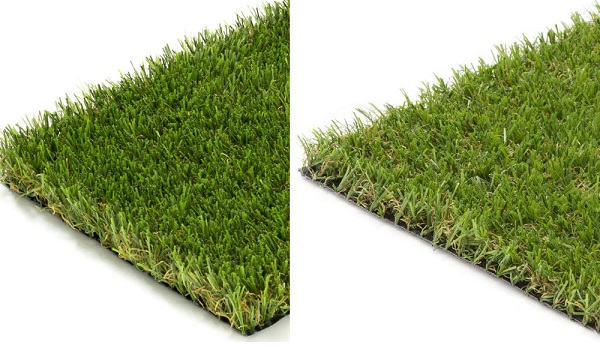
Image courtesy of NeoGrass.
Most manufacturers recommend using a high density product for heavily trafficked areas, and low density product for more aesthetic or ornamental usage. The average pile density is 16,000 to 18,000 stiches per square meter or per 10.76 square feet.
Weight
Weight of turf is calculated by pounds per square yard, which is known as Face Weight. This is the true weight of the fibers only, not the backing.
Should you want to know the total fiber plus backing weight, this is known as Total Weight. Different companies provide different measurements, so make sure you are clear on Face vs. Backing weight or Face vs. Total weight of the product you plan to purchase.
Weight does not determine the quality of the product, it merely provides a metric for overall density. The ideal face weight of a product ranges from 50 to 110 ounces per square yard. The rule of thumb is: the higher the density, the more durable and resilient the product will be to heavy traffic and matting.
Color
The manufacturing process includes the addition of various shades of colored pellets to effect the myriad of colors available in the market, as there are different blends of green used in turf products.
Products can range from bright lime greens to dark olive green and many shades in between. We believe that you should attempt to match the natural surrounding grass, however we also believe that this is a personal preference based on what appeals to your personal aesthetic choice.
Ask your installer for color swatches to make sure you understand the true color of various options. Place the swatches in the project area and view them during various times of the day to see how they appear from various vantage points and under varying sunlight.
Fire Resistance
Most artificial grass is made from non-toxic, non-flammable synthetic fibers, which will not catch fire, but will melt instead. However, it is best to confirm the fire resistant properties of any turf you choose, as well as seek recommendations from your installer on fire prevention. For example, sand-based infill is another method of reducing risk of fire, as the sand has an extinguishing effect.
Average Lifespan of Artificial Grass
Most manufacturers and installers that we researched, give a 20 to 25 year life span for a typical synthetic lawn installation and product warranty. However, most warranty information appears somewhat vague on specifics depending on how the manufacturer perceives that a degradation or failure of the product occurs.
Make sure that your product warranty specifically offers protection against fire or is “fire resistant” and UV resistant – to protect against fading and eventual product breakdown and fiber degradation due to manufacturing and installation defects.
Eco-Friendliness
For low or non-toxicity, look for manufacturers that offer non-toxic, lead-free, toxin-free artificial grass, with solutions catering to usage by children and pets. These vendors will typically have certifications (e.g. EPA, RCRA, EN71-3 European Toy Standards) that show that they exceed all chemical, lead, heavy metal and toxic guidelines.
Though artificial grass can be repurposed or even recycled, not all synthetic grass is equally eco-friendly. The primary challenge of recycling most types of artificial grass is separating the compounds and components used. If a recycling center has this advanced capability, it may not be located within one’s market. However, Royal Grass claims their new EcoSense brand of artificial turf is 100% recyclable.
What are the Advantages of Artificial Grass?
- Easier Maintenance
- Year Round Green Look
- Somewhat Environmentally Friendly (no toxic chemicals or heavy water usage)
- Durability (can withstand heavy foot traffic & recreational activity)
- Does Not Require Irrigation Systems or Heavy Water Usage
- Does Not Need Sunlight
- Effective Drought Tolerant Solution
- Deterrent to Gophers and Moles, when installed with galvanized steel gopher mesh
- Can Support More Usage Scenarios & Settings than Natural Grass
- Can be More Cost-Effective in the Long-Term than Natural Grass
- Helpful Aging-In-Place Solution
- Can be More Attractive than Problematic Lawns
- More Functional than Desert Landscaped Lawns
- Can be Used for High Traffic Areas
- Can be Used for Aesthetic Purposes
What are the Disadvantages of Artificial Grass?
- Lack of Realism and Natural Aesthetic
- Nothing can beat the look, feel and self-sustaining nature of healthy grass
- Better looking synthetic grass costs more
- Artificial Lawns Still Require Maintenance
- On-going upkeep is still necessary, including: cleaning; vacuuming; picking up after pets; brushing matted, high-traffic areas.
- High Surface Temperature During the Summer
- Plastic lawns can become very hot in the late summer months, which can make them unbearable for bare feet and paws
- Consider a solution like ProGreen Cool, if heat is a major concern
- Limited Lifespan
- The color will eventually fade and material will degrade from sunlight exposure, despite manufacturer’s claims of a 20 to 25 year lifespan
- Few Artificial Grass Products are Easily Recyclable
- Although polyethylene, polypropylene and nylon can be recycled when separate, once bound together they form an impenetrable bond that makes them nearly impossible to separate
- Suffocation of Life and Microorganisms Below the Turf
- As the plastic breaks off from years of wear and tear, microplastics find their way into the soil of surrounding trees and plants. The extraction of microplastic from the soil or soil life is not possible today.
- No Organic Benefits to Nearby Wildlife
- Synthetic turf does not sustain grubs, caterpillars, slugs and snails, which help to feed birds. This eventually has an effect on bees, and other pollinators.
- Not All Infills are Eco-Friendly
- Petroleum use, toxic chemicals from infill, unless you choose one of the eco-friendly infills and heightened health and safety concerns.
- Is Heat Intolerant
- Artificial grass will eventually melt from exposure to flames and can be damaged by embers from barbecue grills, heated equipment and intense UV rays
- More Prone to Personal Injury
- Artificial turf is less forgiving on joints than natural turf, and can cause friction burns, when used for more intense recreational activities
- Static Discharge
- Significant Upfront Cost
How Artificial Turf May Impact the Value of Your Home
When installed professionally, using premium quality turf, artificial grass can create an attractive, vibrant landscape to areas with monotonous desert appearances. Homes with environmentally-friendly lawns are lower maintenance, water efficient and cost effective, thereby making them more valuable properties.
Conversely, a poorly installed artificial law with lower quality turf will reduce a home’s curb appeal and ultimately resale value. The point is, take the time to understand your usage needs, budget requirements and the products that are available. Spend time conducting research on landscapers and installers of artificial lawns and make sure to visit the properties where their work is on display. Look for clean borders, straight seams, proper blade directionality and a smooth professional appearance.
Best Uses for Artificial Turf
Historically artificial grass has been used mainly for athletic fields for sports normally played on natural grass such as football, soccer, field hockey and golf. However, there are a number of usage scenarios, besides front and backyard landscaping, that are becoming popular choices for homeowners, as they discover the versatility of newer, more eco-friendly products entering the marketplace.
- Playgrounds and Home Jungle Gyms
- A well-padded artificial lawn can withstand more abuse than its freshly sodded counterparts, while providing more protection than concrete and rocky soils
- Pool Areas
- Instead of harsh concrete hardscaping, add a softer, more elegant solution to the pool’s main area
- Patios/Decks/Balconies/Rooftops
- If you’re installing on patios, rooftops, or porches, it is important that you check the load bearing capacity of the building before installation
- Dog Runs
- Pet owners can turn a portion of their back or side yards into a dog run, using artificial grass as an alternative surface for pets to play. When properly installed, artificial grass drains well, and only requires an enzyme spray after each use to keep pets healthy.
- Driveways
- An alternating checkerboard pattern gives a less harsh look for a home’s curb appeal
- Home Putting Greens
- Add a home putting green without all of the upkeep necessary for the real thing
- Interior/Exterior Wall Covering
- Get the Live Wall look and beauty without all the maintenance.
- Home Gyms
- Because of its quality padding, many home indoor gyms are even installing artificial grass
How to Choose an Artificial Grass Product for Your Project
This section summarizes a portion of a helpful blog post by ProGreen, which explains in detail the different types of artificial turf.
So how do you choose a product that is right for your project?
The key variables that will determine your choice of turf that will best meet your unique needs are: Pile, Weight and Density.
In other words:
Pile + Weight + Density = Your Choice of Product
Here are rules of thumb recommended by ProGreen, when considering different landscape turf products and their height and weight combinations:
Scenario 1: Heavy Use Spaces
↑ Face Weight + ↓ Pile Height = ↑ Density
In other words: heavier Face Weight combined with shorter Pile Height provides more Density.
This combination is ideally suited for heavy use, including pets and lots of foot traffic. Its appearance resembles dense, freshly cut grass.
Scenario 2: Regular Use with Average Length Lawn
↑ Face Weight + ↑ Pile Height = Average Density
In other words: heavier Face Weight combined with taller Pile Height provides average Density.
This combination is well-suited for standard use in residential landscapes. Its appearance resembles an average length lawn.
Scenario 3: Regular Use with Freshly Cut Lawn
↓ Face Weight + ↓ Pile Height = Average Density
In other words: lighter Face Weight combined with shorter Pile Height provides average Density.
This combination is also well-suited for standard use in residential landscapes. Its appearance, however, resembles standard freshly cut grass.
Scenario 4: Low Use Spaces
↓ Face Weight + ↑ Pile Height = ↓ Density
In other words: lighter Face Weight combined with taller Pile Height provides lower Density.
This combination is well-suited for low-use spaces. Its appearance most resembles natural grass (i.e. a less dense lawn at an average length), but would not fare as well as denser turf, if traffic and usage increased.
After deciding on your primary usage and aesthetic preferences, then look for important features within this particular style (e.g. pet-friendly, eco-friendly, heat-mitigating).
How Much Does Artificial Grass Cost?
According to manufacturers’ metrics, the average cost to install artificial lawns is $12.33 per square foot for both materials and labor. This number will vary based on the product type, the type of infill desired (natural or synthetic) and local labor, so a range of $5.50 to $18.75 per square foot takes these parameters into consideration.
Using this average of $12.33, a yard measuring 25×20 feet (500 square feet) would cost a total of $6,125.
Global Syn-Turf, a leading supplier and manufacturer synthetic turf, has a very helpful artificial grass cost calculator that also includes estimates for grass, materials, and rental tools. Another calculator of theirs can be used to compare the total cost of ownership between a natural lawn and an artificial grass yard.
Current prices for artificial turf vary based on pile heights, thickness or density and overall quality. Being penny-wise but pound foolish is a mistake not worth making when it comes to choosing the right product and the right installer for your synthetic lawn.
Best Artificial Grass Manufacturers
- Easy Turf
- Global Syn-Turf
- Golden Moon
- LITA
- MegaGrass
- NeoGrass (UK)
- Pet Grow
- ProGreen
- Royal Grass
- SunVilla
- SYNLawn
- Turfscape
How to Maintain Artificial Grass
Despite what you may have been led to believe, artificial lawns are not maintenance free. However proper maintenance of your lawn should ensure manufacturer’s lifespan claims.
Similar to an indoor or outdoor carpet, artificial grass needs to be maintained by keeping it free of debris, stains, matting and pet mishaps. Dust and dirt can build up on the blades and needs to be rinsed off on occasion to keep your lawn fresh and bright. A simple misting or spray with a garden hose should be routine, at least once a week, especially if you live in dusty terrain.
Stains such as wine, food or other organic matter can be treated with household cleaners and water, the same as you would treat stained carpeting.
Leaves and other light debris on the lawn’s surface should be blown off or raked with care. Be careful to not allow the leaf blower to touch the grass, as it will melt from the engine’s heat. A simple raking or sweeping with a broom of the lawn’s surface will handle the task just as easily.
Overhanging trees and plants can actually drop seeds that will find an amenable environment in artificial turf, thus weeding of your artificial lawn may at times be necessary.
A power broom, which can be purchased or rented at your favorite big box store can help to “refluff” the blades of grass that have been matted down due to heavy usage.
Another tool to accomplish the same task is a push broom that can be pushed in the opposite direction or against the grain of the blades on a hot day, with good pressure on the sweeping motion. The blades will respond to the opposing motion of the broom and fluff up to their installation day positions.
US Turf: General Maintenance of Your Synthetic Lawn
Maintenance is especially important for pet owners as liquid enzyme cleaners should be used to remove pet odors of urine and feces.
US Turf: How to Care for Your Artificial Turf When You Have Pets
How to Install Artificial Grass
This is a written summary of the instructional video by AGL (Artificial Grass Liquidators) embedded at the end of this section.
Once an installer and product are chosen the process can take anywhere from 1 to 3 days, depending on the area to be covered. A 300 to 500 square foot lawn can be completed in under one day. Larger yards approaching 800 to 1000 square feet or more should take 2 to 3 days to install.
- Remove Existing Base
- Add Base
- Add Turf
- Cut to Fit
- Secure Perimeter
- Spread Infill
- Brush Infill
1. Remove Existing Base
The process requires that the landscaper remove the existing base surface, natural grass or pebbles to a depth of at least four inches.
2. Add Base
Class II road base or a similar material is now added to the area of the project. The area is leveled to a smooth even surface and proper drainage before adding gopher mesh and weed barrier to prevent natural intrusions. Note: Weed barrier is not recommended, if you have pets, as this will impede drainage of pet urine and feces.
3. Add Turf
Turf is now ready to be rolled out onto the prepared surface, being careful to allow the product to expand from the sun’s warmth for at least one hour prior to continuing installation. Do not drag the roll of turf and this will dishevel your prepared base. Make sure that the grass blade patterns are facing in the same direction if you use more than one roll.
4. Cut to Fit
Using a box cutter or carpet knife, cut around objects such as trees and hedge bases, from the back of the synthetic grass (stitching side which shows the stich rows). Always leave a quarter to a half inch of turf over edges for the border to insure a professional finish.
If necessary secure different rolls of turf with seam tape and glue, once again ensuring the correct directionality of each roll. Using the red line of the seam tape, create an “S” pattern to make sure each roll receives an appropriate amount of adhesive. Apply pressure to the glued turf by placing infill bags on top of the glued surface seams to help them set in place.
5. Secure Perimeter
Tuck the quarter or half inch edges using a metal putty knife and hammer and either nails or staples. A nail or staple should be placed every six inches on the outside perimeter and every two feet on the inside areas to secure the lawn successfully. Brush the final product with a power broom or push broom for any errant nails or staples before the next step.
6. Spread Infill
Infill is the product placed between the blades of artificial grass to keep the turf standing upright and to keep the lawn weighted to prevent wrinkling, lifting and movement. Make sure you pay attention to the manufacturer’s recommendations for infill requirements in terms of weight, type and amount for the specific product type. Using a drop spreader, similar to the tool for fertilizing a lawn, load the infill into the spreader and slowly work your way around the lawn to evenly disperse the correct amount of infill.
7. Brush Infill
Using either a power broom or stiff push broom, brush the turf to allow the infill to set in and cause the blades to stand up. This step is also useful to re-spread the infill and create a seamless appearance for a more natural looking lawn. The final step is to rinse the blades with water to clear any remaining infill from the length of the grass blades.
AGL (Artificial Grass Liquidators): How to Install Artificial Grass
Additional Resources
- Artificial Grass Liquidators
- AstroTurf
- Field Turf
- Greenplay: Organic Infill Options
- How AstroTurf Got Kicked Off the Field
- MegaGrass EverFlow Technology for Pets
- ProGreen Cool to Combat Heat-Related Issues
- Turf Exchange
- US Turf
- USGreentech
- USGreentech’s Safeshell – The Most Natural Synthetic Turf Infill
Related Articles
- Current State of Landscaping Technology for the Home
- 9 Helpful Gardening Apps to Augment Your Green Thumb
- 7 Ingenious Tech Products for Weed and Pest Control
- Improve Your Landscaping with a Smart Irrigation System
- Are You Ready for a Robotic Lawn Mower?
- 6 Uber-esque Apps for Lawn Care and Outdoor Services
- Why Prescriptive Maintenance is the Cure for Homeowner Headaches
| Purgula is reader-supported. When you click on links to other sites from our website, we may earn affiliate commissions, at no cost to you. If you find our content to be helpful, this is an easy way for you to support our mission. Thanks! Learn more. |

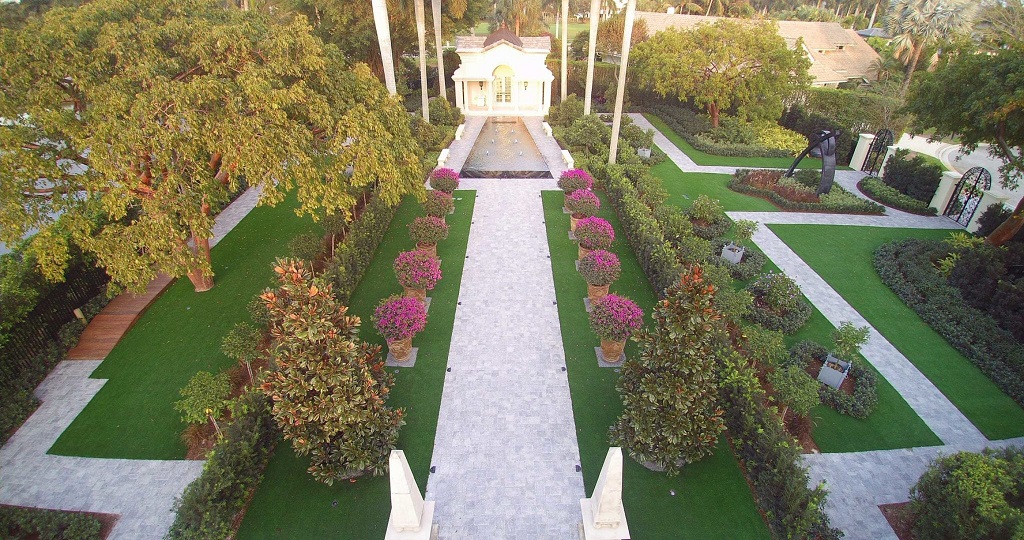
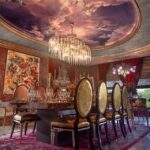

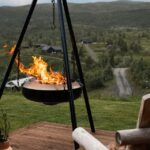
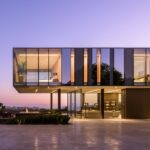

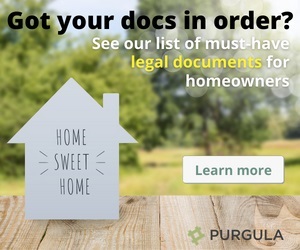
Asia Grass is the first producer of Artificial Grass in Iran & Middle East. If you want to learn about some kinds ofArtificial Grass , you can visit our website and send your questions and request to our formal email.